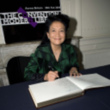Kingdom of Characters (Pulitzer Prize Finalist): The Language Revolution That Made China Modern
(Libby/OverDrive eAudiobook)
Available Platforms
Description
More Details
Excerpt
Similar Titles From NoveList
Similar Authors From NoveList
Published Reviews
Booklist Review
Yale Sinophone studies scholar Tsu examines how Chinese calligraphy was a cherished expression of cultivation and refinement. First standardized 2,200 years ago, it has changed little since. Composed of complex characters rather than the stringing together of alphabetic letters, written Chinese was "China's first and last Great Wall," a perennial barrier to cross-cultural communication. But industrialization and fear of being outflanked by other nations led to a series of incremental innovations--a Chinese-script typewriter, protocols for converting characters to Morse code, a new library card catalog system, and pinyin spelling. Innovators risked their finances, their reputations, and sometimes their lives to meet the challenges of modernization. Political imperatives, including the system of simplified characters promulgated in the 1950s, introduced a dramatic new plasticity into the language, laying the groundwork for bigger stretches to come. But Tsu also emphasizes that "every technology that has ever confronted the Chinese script" also "had to bow before it," as demonstrated by the ubiquity of Chinese script on the internet. Tsu's humanistic, big-picture sensibility makes an otherwise obscure thread in the history of information technology vivid and compelling.
Publisher's Weekly Review
Tsu, a professor of East Asian language and literature at Yale, debuts with an immersive history of the effort to transform the written Chinese language's vast and complex set of characters into a modern communication technology. Noting that Chinese ideographic writing is "fundamentally unique, distinct from any other writing system in the world," Tsu details how China's struggle for sovereignty during the 19th century, when the opium wars resulted in harsh trade agreements and territorial losses, sparked innovations and reform efforts by Chinese scholars, politicians, and inventors who believed the written language was a barrier to development. Tsu describes efforts to develop and promote the Mandarin alphabet, adapt characters for telegraphic transmission, and develop a typewriter to replicate characters. Communist leader Mao Zedong's efforts, meanwhile, to simplify Chinese characters and make the language easier for Westerners to learn dramatically improved the country's literacy rate and eventually reduced the number of characters from tens of thousands to 2,235. Tsu also explores the history of typesetting and modern printing in China, and the evolution of Chinese characters in the internet age. The level of detail occasionally slows the book's pace, but Tsu sheds light on the intriguing interplay between Chinese language and politics. Sinophiles and language buffs will be fascinated. (Jan.)
Library Journal Review
Of all the Chinese dialects why is Mandarin the official one? Why does mainland China use simplified characters and how were they developed? Tsu (East Asian languages and literatures, Yale Univ.; Sound and Script in Chinese Diaspora) answers these questions, and others, in this fascinating history of the Chinese language from 1900 to the present. While the term "character" in the title refers to the symbols used to write the Chinese language, it could also refer to all the colorful figures who appear in this history, including Du Dingyou, who saved 300,000 books from his university library from destruction during World War II, and Zhi Bingyi, who, while in a jail cell in 1968, saw an element in the components of Chinese characters that helped him to develop the coding method for computer processing. Other topics featured in Tsu's comprehensive history include Romanization, Chinese typewriters, telegraphy, and library classification systems. The book is rounded out with illustrations of variants of characters from Hong Kong, mainland China, and Taiwan. VERDICT Essential reading for anyone interested in Chinese language or modern Chinese history.--Joshua Wallace
Kirkus Book Review
How the oldest living written language has had to modernize and adapt. Because of the highly complicated ideographic nature of the Chinese written language, both the West and China's own people have long striven to decipher its meaning and power. Traditionally, only the elite could master the elaborate script, since it took too long to write and was hard to learn. When China was confronted with "catching up" with the West by the late 19th century, the task of modernizing and adaptation was enormous. Tsu, a Yale professor of East Asian studies who emigrated from Taiwan to the U.S. as a child, has a unique and poignant perspective on having to adapt to the Western alphabet and a different mode of critical thinking. "The two language worlds did not accord; they clashed," she writes. The author reviews the basic properties of the Chinese script as it transformed via characters, strokes, components, radicals, and tone. She explores Wang Zhao's first attempts to modernize Mandarin during the mid-1900s in the spirit of reform and in response to Japan's attempts to modernize its own language; the first mapping of the ideographic keyboards for typewriters (adapted for a few thousand commonly used Chinese characters rather than the letters of the Roman alphabet), which allowed Chinese to become a part of the telegraphy revolution; the deconstruction of the language for categorizing and indexing for libraries; and the Communist Party's attempts to simplify and modernize in the 1950s using roman script instead of ideograms. Purists might object, but literacy rates have increased hugely--to 96.8 percent by 2018, according to Tsu's reckoning. The linguistic and historical threads the author weaves together are complex, but her engaging tone makes the book accessible for general readers. An engaging, relevant work that delves into the linguistic past in order to predict China's future success in the world. Copyright (c) Kirkus Reviews, used with permission.
Booklist Reviews
Yale Sinophone studies scholar Tsu examines how Chinese calligraphy was a cherished expression of cultivation and refinement. First standardized 2,200 years ago, it has changed little since. Composed of complex characters rather than the stringing together of alphabetic letters, written Chinese was "China's first and last Great Wall," a perennial barrier to cross-cultural communication. But industrialization and fear of being outflanked by other nations led to a series of incremental innovations—a Chinese-script typewriter, protocols for converting characters to Morse code, a new library card catalog system, and pinyin spelling. Innovators risked their finances, their reputations, and sometimes their lives to meet the challenges of modernization. Political imperatives, including the system of simplified characters promulgated in the 1950s, introduced a dramatic new plasticity into the language, laying the groundwork for bigger stretches to come. But Tsu also emphasizes that "every technology that has ever confronted the Chinese script" also "had to bow before it," as demonstrated by the ubiquity of Chinese script on the internet. Tsu's humanistic, big-picture sensibility makes an otherwise obscure thread in the history of information technology vivid and compelling. Copyright 2021 Booklist Reviews.
Library Journal Reviews
The John M. Schiff Professor of East Asian Languages and Literatures and Comparative Literature as well as chair of the Council on East Asian Studies at Yale, Tsu argues that China was transformed over the last century into the powerhouse it is today by a prolonged battle to make the Chinese language accessible to the modern world of global trade and digital technology. Along the way, she reveals language to be both a tool and a source of power.
Copyright 2021 Library Journal.Library Journal Reviews
Of all the Chinese dialects why is Mandarin the official one? Why does mainland China use simplified characters and how were they developed? Tsu (East Asian languages and literatures, Yale Univ.; Sound and Script in Chinese Diaspora) answers these questions, and others, in this fascinating history of the Chinese language from 1900 to the present. While the term "character" in the title refers to the symbols used to write the Chinese language, it could also refer to all the colorful figures who appear in this history, including Du Dingyou, who saved 300,000 books from his university library from destruction during World War II, and Zhi Bingyi, who, while in a jail cell in 1968, saw an element in the components of Chinese characters that helped him to develop the coding method for computer processing. Other topics featured in Tsu's comprehensive history include Romanization, Chinese typewriters, telegraphy, and library classification systems. The book is rounded out with illustrations of variants of characters from Hong Kong, mainland China, and Taiwan. VERDICT Essential reading for anyone interested in Chinese language or modern Chinese history.—Joshua Wallace
Copyright 2021 Library Journal.Publishers Weekly Reviews
Tsu, a professor of East Asian language and literature at Yale, debuts with an immersive history of the effort to transform the written Chinese language's vast and complex set of characters into a modern communication technology. Noting that Chinese ideographic writing is "fundamentally unique, distinct from any other writing system in the world," Tsu details how China's struggle for sovereignty during the 19th century, when the opium wars resulted in harsh trade agreements and territorial losses, sparked innovations and reform efforts by Chinese scholars, politicians, and inventors who believed the written language was a barrier to development. Tsu describes efforts to develop and promote the Mandarin alphabet, adapt characters for telegraphic transmission, and develop a typewriter to replicate characters. Communist leader Mao Zedong's efforts, meanwhile, to simplify Chinese characters and make the language easier for Westerners to learn dramatically improved the country's literacy rate and eventually reduced the number of characters from tens of thousands to 2,235. Tsu also explores the history of typesetting and modern printing in China, and the evolution of Chinese characters in the internet age. The level of detail occasionally slows the book's pace, but Tsu sheds light on the intriguing interplay between Chinese language and politics. Sinophiles and language buffs will be fascinated. (Jan.)
Copyright 2021 Publishers Weekly.Reviews from GoodReads
Citations
Tsu, J. (2022). Kingdom of Characters (Pulitzer Prize Finalist): The Language Revolution That Made China Modern (Unabridged). Books on Tape.
Chicago / Turabian - Author Date Citation, 17th Edition (style guide)Tsu, Jing. 2022. Kingdom of Characters (Pulitzer Prize Finalist): The Language Revolution That Made China Modern. Books on Tape.
Chicago / Turabian - Humanities (Notes and Bibliography) Citation, 17th Edition (style guide)Tsu, Jing. Kingdom of Characters (Pulitzer Prize Finalist): The Language Revolution That Made China Modern Books on Tape, 2022.
Harvard Citation (style guide)Tsu, J. (2022). Kingdom of characters (pulitzer prize finalist): the language revolution that made china modern. Unabridged Books on Tape.
MLA Citation, 9th Edition (style guide)Tsu, Jing. Kingdom of Characters (Pulitzer Prize Finalist): The Language Revolution That Made China Modern Unabridged, Books on Tape, 2022.
Copy Details
| Collection | Owned | Available | Number of Holds |
|---|---|---|---|
| Libby | 1 | 0 | 0 |
































